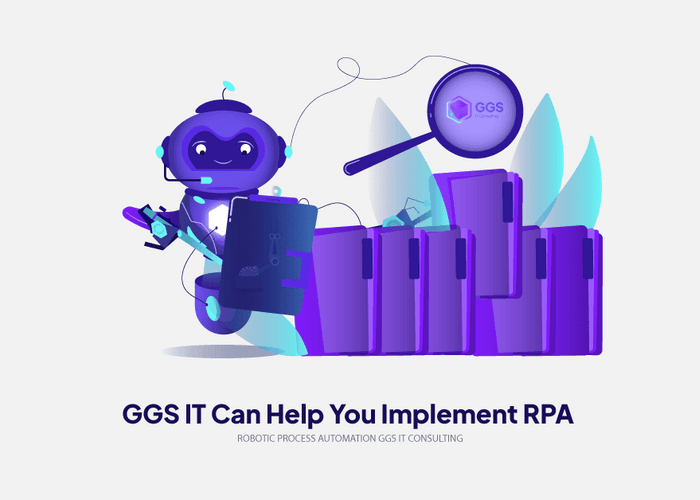Business Process AutomationLearn more
Implementation of Robotic Process Automation- step by step

Many business owners and CIOS are looking into robotic process automation (also known as RPA) to help teams and staff. RPA is also an excellent way to cut down on tedious and repetitive tasks. RPA tools can significantly free up corporate workers and help them focus on work that requires a more human touch with higher value.
However, RPA requires very specific design and planning to ensure that its implementation and delivery is ideal. The delivery process is crucial in this respect.
Before investing in RPA implementation, it’s important to understand exactly how this business process works. In this in-depth guide, we’re going to explore exactly what robotic process automation is and how the delivery process works, step-by-step.
What is RPA?
Robotic process automation (a.k.a. RPA) is the application of robotics technology, specifically for the purpose of automating business processes. RPA is governed by business logic and highly structured and formulated inputs. By using these tools, a business can then create or configure software (the “robot” in this case) to find and interpret applications in order to process and manipulate data, as well as communicate with other systems and triggering responses.
There are a ton of RPA scenarios out there. You could have something as small as an automatic out-of-office email or something as large as entire streams of bots.
To put it simply, RPA refers to applications or software that a business can use to automate various small, tedious, time-consuming tasks, rather than leaving that job in the hands of humans. RPA implementation can improve productivity, make the entirety of the business more efficient, reduce time wasted, and save businesses a lot of money.
Now that we know what RPA actually is, let’s break down the delivery and implementation process step-by-step.
The Step-by-Step RPA Implementation Delivery Process
To implement RPA into your existing systems, GGS IT Consulting will follow a few key steps:
At the beginning, we look for an ideal process for RPA. This involves a one to three hour meeting in which we brainstorm and identify the right list of potential processes to optimize with RPA. We’ll then analyze the process, business legitimacy, and expected returns with the client business team. Process evaluation will take around three to five days. Our consultant and resident RPA developer will meet with business reps and the company’s IT head. We’ll prepare estimation and overall scope of the work, as well as analyze process exceptions and prepare an as-is process map. Then, it’s time to jump into development. This process will take between six and twenty-one days, depending on the heftiness of the project. We’ll keep in touch with the business leads for consulting purposes only, and our RPA developer will work closely with the business’s IT department. From here, we will create a task backlog, develop a detailed and thorough implementation plan, begin developing the bot, and start preparing the Solution Design Document (SDD). The client accepts the RPA implementation at this point, or our team will revisit the pilot and fix bugs or other issues accordingly. We’ll then begin User Acceptance Testing (UAT). This process takes between one to three days and will involve the business as a whole, the IT department, and our RPA developer. We’ll conduct a variety of acceptance tests through the client’s environment. We’ll then implement any necessary changes to ensure that the transition is as seamless and user-friendly as possible. It’s time to finally go live! This final delivery step will take around one to three days. We’ll move the developed, final bot into the production environment and begin training end users. Beyond implementation, we’ll work to support your team through the transition and offer solutions and tech support in case there are any issues in the future.
RPA implementation should be able to provide gains across all of your metrics. If this isn’t happening, there are a few things to consider. The task you’ve chosen to automate could simply be too complex and better handled by humans. Your RPA bot could also be poorly designed, or not designed in a way that is ideal to use for that specific process. In this case, start the checklist over again with a new process or RPA bot.
In fact, the best way to avoid this kind of situation and to develop and implement a strong, futureproof RPA bot is to utilize the services of experienced developers and business-focused individuals from a firm like GGS IT Consulting.
GGS IT Consulting for Robotic Process Automation
At GGS IT Consulting, we know the value of RPA implementation. When RPA is introduced to a company, a ton of benefits come from it. From knowledge sharing to lower costs to higher employee satisfaction, RPA can make a huge difference in the quality and efficiency of your company.
Suddenly, time-consuming albeit simple tasks are a thing of the past. And for many forms of RPA, there is no need to monitor these processes, meaning they are “unattended” or without human supervision. Your teams will now have the freed up time to focus on more important things within your company.
Are you unsure in robotic process automation is right for your business? Get in touch with one of our consultants today. We’ll break down how well RPA solutions fit into your specific industry and niche, and exactly what you need to do to get started. Book your FREE CONSULTATION session here!
How was our step-by-step guide to robotic process automation delivery? Get in touch with us today to learn more about how GGS IT Consulting can help you bring your business to the future.
